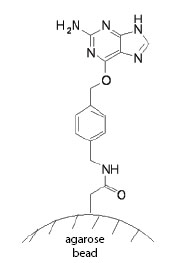上海金畔生物科技有限公司代理New England Biolabs(NEB)酶试剂全线产品,欢迎访问官网了解更多产品信息和订购。
产品信息
The SNAP-tag protein labeling system enables the specific, covalent attachment of virtually any molecule to a protein of interest. The SNAP-tag is based on human O6-alkylguanine-DNA-alkyltransferase (hAGT). SNAP-tag substrates are fluorophores, biotin or beads conjugated to guanine or chloropyrimidine leaving groups via a benzyl linker. In the labeling reaction, the substituted benzyl group of the substrate is covalently attached to the SNAP-tag.
There are two steps to the use of this system: sub cloning and expression of the protein of interest as a SNAP-tag fusion, and capture and immobilization of the fusion protein using SNAP-Capture Pull Down Resin.
For larger volume requirements, customized and bulk packaging is available by purchasing through the OEM/Bulks department at NEB. Please contact [email protected] for further information.

- 产品类别:
- Discontinued (<3 years)
-
特性和用法
需要但不提供的材料
- Protein sample containing the protein to immobilize expressed as a SNAP-tag fusion
- Buffer for immobilization and washing
- Microcentrifuge
结合容量
SNAP-Capture Pull Down Resin (80 µl) was washed, incubated with 200 µl of 1 mg/ml SNAP-tag CBD (Chitin Binding Domain) for 1 hour at room temperature, then rewashed as described in these instructions. Binding capacity was determined to be 1 mg/ml bed resin.
-
注意事项
- Storage of Pull Down Resin: Do notfreeze the SNAP-Capture Pull Down Resin. Store the unused resin at 4°C. Withproper storage, resin should be stable for at least Two years.
- Correct storage and handling of SNAP-tag fusion proteins is essential tomaintain reactivity of the SNAP-tag prior to immobilization.
- SNAP-tag fusion proteins can be purified before immobilization, but theimmobilization reaction also works in non-purified protein solutions includingcell lysates.
- Add 1 mM DTT to buffers used for the storage of SNAP-tag fusion proteins.Protein samples should be stored at -20°C, or at -80°C for long-term storage.Handling at temperatures above 0°C should be minimized by thawing the SNAP-tagprotein samples shortly before use, and keeping them on ice until just beforethe immobilization.
- If a particular fusion protein requires buffers without reducing agents, payparticular attention to minimize all handling steps of the protein above 4°Cbefore the labeling reaction.
- The SNAP-tag itself is tolerant of a wide range of buffers. The requirements ofyour fusion partner should dictate the selection of the buffer. The followingstorage buffer composition is recommended, especially when freezing proteinmaterial: pH between 7.0 and 8.0, monovalent salts (e.g. sodium chloride)between 50 mM and 250 mM, and at least 1 mM DTT. Non-ionic detergents can beadded if required, but ionic detergents should be avoided because they reducethe activity of the SNAP-tag. Many proteins benefit from the addition ofglycerol for frozen storage, typically 20% v/v.
- Immobilized SNAP-tag fusion proteins should be stored at 4°C. Sodium azide maybe added to 2 mM final concentration to prevent bacterial growth. Depending onthe stability of the fusion partner, under these conditions the immobilizedprotein should be stable at 2–6°C for several months. The SNAP-Capture Pull Down Resin should not be frozen.
- The SNAP-tag fusion protein is linked to the SNAP-Capture Pull Down Resin by acovalent bond. Therefore the immobilized protein is essentially irreversiblybound to the resin. It is important however to preserve the functional stabilityof the protein fused to the SNAP-tag as much as possible. We recommend handlingthe immobilized fusion protein and storing between use at 4°C, to prepare itjust before use, and to handle it as gently as possible.
操作说明、说明书 & 用法
-
操作说明
- Use SNAP-Capture Pull Down Resin (S9144)
工具 & 资源
-
选择指南
- Comparison of SNAP-tag®/CLIP-tag™ Technologies to GFP
FAQs & 问题解决指南
-
FAQs
- Cellular Imaging and Analysis FAQs
-
问题解决指南
- Labeling with SNAP-tag® Technology Troubleshooting Guide
